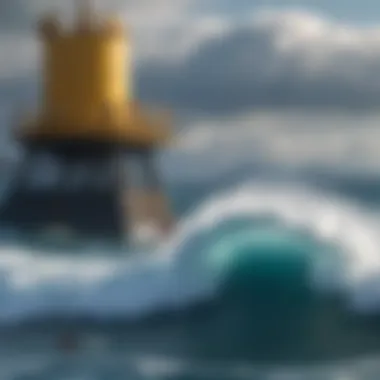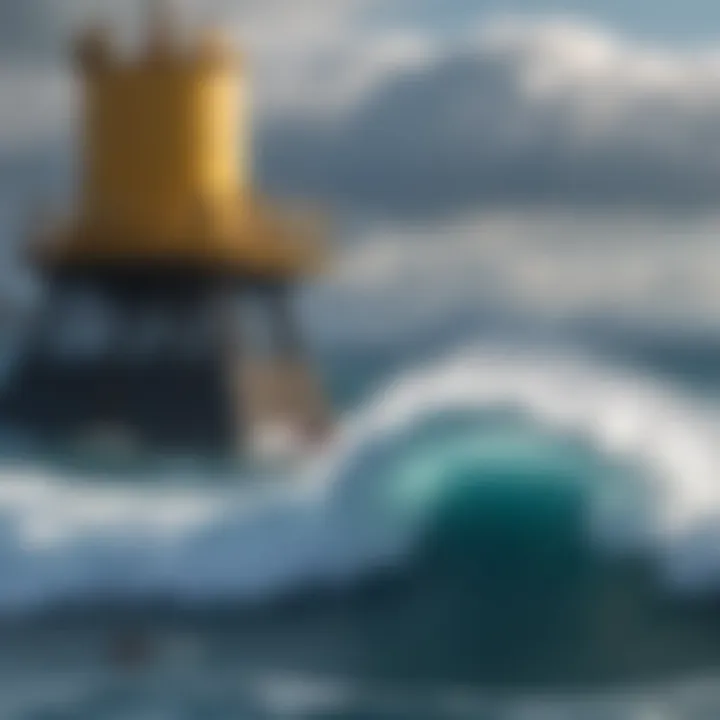Harnessing Oceanic Energy for Sustainable Electricity


Intro
The rise of renewable energy sources has prompted a fascinating exploration into various methods of harnessing natural forces. Among these, ocean waves stand out for their immense potential. The ocean is a colossal energy reservoir, with waves continually rolling in from distant storms and winds. By understanding the intricate dynamics of wave energy, we can unlock a significant avenue for sustainable electricity generation.
While some may think of waves only in terms of recreational watersports, the reality is they represent untapped power. This article will examine not merely the mechanics of converting wave motion into usable energy but also the technologies that have sprung up to support this industry. Additionally, we will gaze into the benefits this resource offers, alongside the challenges and environmental considerations that come with its exploitation.
As we navigate through this topic, expect to uncover the various techniques involved, discover the indispensable equipment for capturing wave energy, and gain insights into real-world applications. Understanding these factors can prepare aspiring innovators, environmental advocates, and energy enthusiasts to appreciate the broader implications of what harnessing oceanic energy entails.
Foreword to Wave Energy
In recent years, wave energy has emerged as a viable player in the quest for sustainable energy solutions. It stands distinctly apart, drawing its power from the kinetic and potential energy inherent in ocean waves. Rather than relying solely on sunlight or the wind, harnessing this untapped resource could reduce our dependence on fossil fuels while contributing meaningfully to the global energy mix.
Overview of Wave Energy
Wave energy refers to the energy generated by ocean waves, which are influenced by wind and gravitational forces. The consistent movement of waves can be converted into electricity through various technologies. One might imagine the rhythmic rise and fall of the waves along the shore, a natural dance that is not just aesthetically pleasing but is also bursting with energy waiting to be utilized.
The process usually involves devices that are designed to capture this movement—think of platforms that bob up and down, or floating structures that oscillate with wave motion. Many of the technologies being explored today demonstrate remarkable potential. For instance, they exhibit high energy density compared to other forms of renewable energy. This potential, however, demands thoughtful consideration and further investigation.
Importance in Renewable Energy Context
In today’s world, the shift towards cleaner energy sources is not optional but necessary. Wave energy possesses unique advantages:
- Abundance: The oceans cover over 70% of our planet's surface. This vast resource is only starting to be tapped.
- Consistency: Unlike sun and wind energy, which are variable, waves can provide a more reliable source of energy, stemming from daily tidal patterns and seasonal weather changes.
- Complement to Other Renewables: When integrated with solar and wind systems, wave energy can create a more stable energy grid by providing a continuous power supply, capitalizing on periods when sun and wind are scarce.
"Wave energy is not just a fleeting trend; it's a critical element in the mosaic of renewable energy initiatives that can fortify our energy independence and sustainability goals as we face climate change."
As we sift through the complexities of energy generation, understanding wave energy is paramount. This allows us to evaluate its potential effectively and ascertain how best to implement its use in a changing landscape. The coming sections will shed light on the science behind waves and explore the latest technologies aimed at harnessing this energy source effectively. It is a frontier that invites exploration and innovation, and its importance in the broader renewable energy conversation cannot be overstated.
The Science of Waves
Describing the intricacies of wave energy involves understanding both the physical properties of ocean waves and the dynamics governing their formation. The study of these waves is foundational to appreciating how we can harness their potential for electricity generation. Waves are not just random ripples on the surface; they contain significant energy that can be converted into usable electrical power.
In this section, we unravel the dynamic behavior of waves and explore their different types, each contributing uniquely to the field of wave energy. By dissecting wave dynamics and categorizing the various wave types, we set the stage for a deeper comprehension of wave energy conversion technologies and strategies.
Wave Dynamics
Wave dynamics encompass the physical forces and phenomena that create and influence ocean waves. Key factors like wind speed, duration, and fetch play vital roles in determining wave characteristics. Wind generates energy, which is transmitted to the water's surface, creating waves that can travel vast distances.
Key concepts of wave dynamics include:
- Wave height: The vertical distance between the crest of a wave and its trough. High waves contain more energy, making them more suitable for conversion into electricity.
- Wave period: The time it takes for two successive wave crests to pass a fixed point. A longer wave period often indicates a more powerful wave.
- Wave frequency: The number of waves passing a point in a given time, related directly to energy concentration.
Understanding these parameters is critical. It enables engineers and scientists to calculate the potential energy available from specific sites in oceanic environments, which is essential for potential wave energy projects.
Types of Ocean Waves
Ocean waves can be classified into various categories based on their formation mechanisms and physical characteristics. The primary types include capillary waves, gravity waves, and tsunamis.
Capillary Waves
Capillary waves are small, rippling waves typically characterized by their wavelengths of less than 1.7 centimeters. They’re primarily generated by the wind. These waves play a significant role in the processes of air-sea interaction, crucial for heat and gas exchange.
The key characteristic of capillary waves is their ability to form quickly when there’s a light breeze. Their unique feature lies in their sensitivity to wind: even minor gusts can create a myriad of capillary waves. While they contribute less energy than larger wave types, understanding them helps in studying wave development in the initial stages, making them beneficial for modeling purposes.
Gravity Waves
Gravity waves are more significant than capillary waves, typically generated by winds over longer distance and duration. They are characterized by their larger heights and longer wavelengths, sometimes extending hundreds of meters.
These waves are important because they carry substantial energy. The key feature is their formation process, which involves wind energy transferring to the sea surface, creating waves that build on top of each other. The advantage of gravity waves for energy generation lies in their ability to store and transport vast amounts of energy over great distances. Consequently, they are widely studied in wave energy applications, as they yield potential power for conversion.
Tsunamis


Tsunamis, while often associated with disasters, represent a different paradigm in wave energy dynamics. Triggered primarily by underwater seismic activity, these waves travel at high velocities across ocean basins, reaching heights far greater than standard waves.
The key characteristic of tsunamis is their long wavelengths and immense energy concentration. They can cause significant damage when they hit coastal areas but offer unique opportunities for energy harnessing if proper technologies can be designed. The challenge with tsunamis, however, is the unpredictability and the fact that their waves do not occur frequently—they are therefore not a consistent energy source but rather a point of interest for innovative engineering solutions that seek to utilize their immense energy release.
Technologies for Wave Energy Conversion
Ocean waves, with their relentless motion and immense energy potential, present a formidable opportunity for innovative electricity generation methods. The technologies for wave energy conversion play a pivotal role in tapping into this power source. They vary widely, each designed to capture the energy from waves and convert it into usable electricity. The successful development and deployment of these technologies not only contribute to the diversification of renewable energy sources but also address the pressing need for sustainable alternatives in our energy mix.
The importance of these technologies cannot be overstated. They pave the way for economies to harness the raw, untapped energy presented by oceans. Given that wave energy is predictably available and consistent, its conversion methods stand as a promising solution to mitigate climate change while enhancing energy security. Let’s delve deeper into the various wave energy conversion technologies.
Overview of Conversion Technologies
Various technologies exist for converting wave energy into electricity, and they generally fall into several primary categories.
- Point Absorbers: These are floating structures that move up and down with the waves, utilizing this motion to generate power.
- Oscillating Water Columns: This technology uses the air-pressure changes created by wave motion to turn turbines.
- Overtopping Devices: These devices capture water in a reservoir as a wave overtops a barrier, using gravitational force to produce power.
- Attenuators: They comprise long floats that move with the waves and can capture energy through the relative motion between segments of the structure.
Each of these systems has unique attributes that cater to different oceanographic conditions and energy requirements. The suitability of each technology often depends on various factors, including wave characteristics, environmental impact, and economic feasibility.
Point Absorbers
Point absorbers are designed to capture energy from wave motion in a single point, typically a buoy-like structure. As waves rise and fall, the buoy moves in response to the changing water levels, engaging a mechanical system that converts this kinetic energy into electrical energy.
This technology is particularly advantageous because it can be deployed in deeper waters, minimizing the impact on coastal environments. Additionally, point absorbers generally have a smaller footprint, making them less intrusive. Such efficiency fosters the prospect of widespread adoption in the quest for renewable energy solutions.
Oscillating Water Columns
Oscillating water columns operate on a slightly different principle. They feature a partially submerged chamber where waves create air pressure differences. As the water rises and falls, the trapped air moves through a turbine, generating electricity.
This kind of technology is quite robust, able to withstand severe ocean conditions. Its ability to work with varying wave heights makes it flexible for diverse locations. Various designs, from inshore to offshore implementations, further expand the applicability of oscillating water columns.
Overtopping Devices
Overtopping devices utilize a unique method where waves are directed over a barrier, allowing water to accumulate in a reservoir. As the water flows back into the ocean, it drives turbines, thus generating energy as it does so. The cyclic nature of this process allows for a constant energy output as long as waves are present.
While they can require significant infrastructure investment, the potential for large-scale energy production makes overtopping devices an intriguing option for coastal energy projects.
Attenuators
Attenuators are elongated structures that float on the water's surface. As different segments of the device move with the waves, the relative motion between them is harnessed to generate electricity. This motion is typically transformed into mechanical energy, which can be converted into electrical power.
These devices can be scaled up or down depending on energy needs, making them versatile. Their design can reduce wave energy’s destructive impact on coastal areas by dissipating it before reaching the shore. Additionally, it’s worth mentioning that the installation of such devices can sometimes lead to habitat creation for marine life, presenting potential ecological benefits.
Benefits of Wave Energy
The exploration of wave energy not only opens the door to innovative technologies but also highlights several key benefits that underpin its significance in the broader renewable energy landscape. This section delves into the fundamental advantages of wave energy, emphasizing its potential as a sustainable resource, its environmental impacts, and its role in bolstering energy security.
Renewable and Abundant Resource
When discussing wave energy, it's hard not to mention its availability. The ocean is an immense reservoir of energy. According to estimates, the energy contained in ocean waves could provide substantial amounts of electricity if harnessed effectively. This dramatically contrasts with traditional fossil fuels, which are finite and rapidly depleting.
Wave energy offers the prospect of endless supply, washing ashore with tides and swells, day in and day out. The vastness of our oceans means that there is potential for numerous installations along coastlines without exhausting the resource. Researchers believe that if we could capture even a fraction of the energy from waves, we could power millions of homes. Here's what makes it stand out:
- Consistency: Waves are predictable and can be forecasted accurately, unlike some other renewable sources such as wind or solar.
- Global Accessibility: Coastal regions can tap into wave energy more easily, making it accessible to various nations worldwide.
- Minimal Land Use: Unlike land-based energy sources, oceans allow for installations that often have a smaller land footprint.
Environmental Advantages
Harnessing wave energy does more than just yield electricity; it may also serve as a mitigating strategy against climate change. Since wave energy conversion systems do not rely on greenhouse gas emissions, they are inherently cleaner. The advantages here include:
- Reduction of Carbon Footprint: Wave energy technologies can lead to a significant decrease in carbon emissions compared to fossil fuel-based systems.
- Less Land Disruption: Ocean sites typically have less ecological footprint than traditional wind or solar farms, enabling the maintenance of terrestrial habitats.
- Habitat Creation: Some wave energy devices can function as artificial reefs, offering increased marine biodiversity in nearby areas.
Admittedly, the potential negative impacts on marine wildlife must not be overlooked. Careful planning and impact assessments are essential to create a balance that favors both energy generation and ecological preservation.
Potential for Energy Security


In an age where energy independence is crucial, wave energy can play a formidable role in enhancing energy security. By diversifying the energy mix, nations can reduce their reliance on imported fossil fuels, which are often subject to volatile prices and geopolitical tensions.
This is how wave energy contributes to energy security:
- Local Power Generation: With seaside installations, coastal nations can capitalize on their natural resources, harnessing energy close to where it is consumed.
- Resilience Against Supply Shocks: As wave energy facilities can complement other renewable sources, they create a more resilient grid that is less prone to disruptions caused by external forces.
- Job Creation: The establishment and maintenance of wave energy projects can stimulate local economies, creating jobs and supporting communities.
In summary, the benefits of wave energy cannot be overlooked. By tapping into this renewable resource, we can forge a path toward more sustainable, cleaner, and reliable energy solutions. > "It’s not just about energy, but about creating a new relationship with our planet and its resources."
In the quest for innovative energy solutions, wave energy remains a critical player in reshaping how we approach electricity generation in an eco-friendly way.
Challenges in Wave Energy Implementation
The journey towards harnessing wave energy comes with a fair share of hurdles. These challenges are critical to understand, as they influence the broader acceptance and adoption of wave energy solutions. In essence, identifying these issues lays the groundwork for innovative approaches that can potentially lead to successful implementations. It’s essential for investors, policymakers, and engineers to communicate openly about these obstacles in order to pave the way forward.
Technical Barriers
When we discuss technical barriers in wave energy implementation, we’re essentially talking about the specifics of the technologies that convert oceanic movement into usable electricity. One significant issue arises from the harsh marine environment. Engineers design wave energy converters (WECs) to withstand high forces and corrosive saltwater, which can lead to faster wear and tear. For instance, numerous prototypes have faced mechanical failures due to strong wave conditions that were not factored into initial designs. This leads to costly repairs and maintenance.
- Durability Issues: Equipment must be robust enough to handle significant stress without frequent downtime.
- Efficiency Levels: Not all technologies convert wave energy efficiently. Optimizing energy capture is a continuous struggle.
- Site-Specific Designs: WECs often need to be tailored to specific geographical locations, complicating widespread implementation.
Economic Considerations
From an economic standpoint, the wave energy sector is still regarded as a nascent market compared to wind and solar energy. Investment levels lag, making it challenging for technology developers and companies to secure funding. Moreover, high installation and maintenance costs can deter initiative. There are several elements at play:
- Capital Investment: Setting up wave energy systems requires significant upfront costs which can be a non-starter for many investors.
- Reliability and Return on Investment: Stakeholders worry about the feasibility of achieving a reliable energy supply; without proven success rates, justifying expenses becomes difficult.
- Price Competitiveness: Wave energy needs to compete with more established renewable sources like solar and wind, which can offer lower costs and faster returns.
Regulatory Hurdles
Navigating the regulatory landscape for wave energy projects can feel like traversing a minefield. Depending on the region, water rights, environmental impact assessments, and local regulations can complicate the development process. Understanding compliance requirements is key.
- Permitting Delays: Obtaining necessary permits can take years, leading to missed opportunities in a rapidly evolving energy market.
- Environmental Regulations: Impact assessments are critical to ensure that marine ecosystems are not disrupted, which can sometimes result in stringent requirements and additional costs.
- Policy Stability: The lack of a unified or comprehensive policy framework to support wave energy adoption may create uncertainties for investors and project developers.
"Natural resources are both an asset and a responsibility. Harnessing them demands care, especially when steering away from the offshore oil rig mentality towards more sustainable energy solutions."
Understanding these challenges equips stakeholders with the knowledge they need to navigate through complex interactions involved in forging ahead with wave energy initiatives. By tackling technical, economic, and regulatory issues collectively, the path towards harnessing oceanic energy can become a more attainable goal.
Environmental Considerations
The exploration of wave energy is not just about harnessing a potent source of renewable energy; it's also tangled up with countless environmental considerations. As we engage in extracting energy from oceanic waves, we inevitably alter the balance of marine ecosystems. The importance of discussing these considerations lies in ensuring that the benefits of wave energy do not come at the cost of marine biodiversity and ecological health.
Impact on Marine Ecosystems
Harnessing wave energy can disturb marine habitats, which house an astonishing array of species, from the smallest plankton to the largest whales. Activities involved in wave energy conversion can change sediment dynamics and modify habitats that many marine organisms rely on. For instance, the installation of underwater turbines and buoys can influence local currents and, consequently, the way nutrients are distributed in coastal areas.
Additionally, there’s the noise pollution created by machinery that could interfere with marine life communication and navigation. Fish, for example, are sensitive to sound, and excessive noise could drive them away from breeding or feeding grounds. Effects can snowball, leading to long-term repercussions on the ecosystem. The encroachment on habitats by the infrastructure can also lead to changes in species distribution, occasionally favoring certain species over others—a phenomenon that can upset the delicate ecological balance.
Mitigation Strategies
To ensure that the deployment of wave energy technologies is not detrimental, the industry must adopt robust mitigation strategies aiming to lessen environmental impacts. First and foremost, doing comprehensive environmental impact assessments before construction can pinpoint potential issues.
Here are several strategies that are gaining traction:
- Site Selection: Choosing locations that minimize disruption to sensitive habitats is critical. Areas with already existing human use—like ports—can be more suitable.
- Use of Eco-friendly Materials: Gradual shifts towards materials that have less environmental impact can reduce the carbon footprint of installations.
- Monitoring Programs: Ongoing studies to evaluate the impact of wave energy devices on marine life help in adjusting operational parameters to protect vulnerable species proactively.
- Adaptive Management: This strategy entails continuously tweaking operations based on observed environmental conditions. It's about staying flexible and responsive to what is learned through monitoring.
"By weaving these strategies into the fabric of wave energy development, we can strike a balance between utilizing the ocean’s power and preserving its delicate ecosystems."
In summary, navigating through the complexities of environmental considerations tied to wave energy is essential for sustainable development. With wise strategies in place, it is conceivable to benefit from this renewable resource while preserving marine ecosystems for future generations.
Case Studies of Wave Energy Projects
Examining case studies of wave energy projects plays a crucial role in understanding the practical applications and challenges of harnessing ocean energy. By analyzing successful initiatives and lessons learned from pilot projects, we can gather insights on the feasibility, effectiveness, and potential of wave energy technologies. This examination not only holds academic interest but also presents real-world implications for adopters and advocates of renewable energy.
Successful Initiatives Worldwide


Across the globe, numerous wave energy projects have emerged, showcasing the possibilities of turning oceanic dynamics into usable energy. One noteworthy initiative is the WaveRoller project from Finland. This device operates by capturing energy from waves approaching the shore. It converts kinetic energy into electricity through a series of oscillating panels. The continuous operation and minimal environmental impact mark it as a prime example of effective wave energy harnessing.
Another exemplary project is the Scottish Power Renewables' Pelamis Wave Energy Converter. This technology consists of a series of articulated sections that float on the sea surface. The motion of the waves causes these sections to flex, generating electricity via hydraulic pumps. The success of this initiative suggests that deploying wave energy systems in regions with consistent wave patterns can lead to reliable energy output.
- Key points to note:
- Viability in different ocean conditions affects project success.
- Innovations in technology are essential for efficiency.
- Collaborative efforts between researchers and energy companies enhance outcomes.
Lessons Learned from Pilot Projects
While the successes provide a hopeful outlook, several pilot projects have offered important lessons that shape future endeavors. One essential takeaway is that understanding local marine ecosystems is vital. Projects like Wave Hub in England faced challenges not just from technical perspectives but also from environmental regulations. Ensuring compliance with local wildlife preservation can significantly impact project timelines and costs.
Moreover, economic factors often dictate the progress of wave energy projects. The New Jersey Wave Energy Testbed project revealed that while the technology was promising, the high initial investments and uncertain long-term returns created a hesitance among investors. Strategies involving phased advancements and public funding can mitigate these financial barriers.
In terms of technical failures, several pilot projects have had to pivot or close due to maintenance challenges or the system's inability to cope with extreme weather conditions. These experiences illustrate the need for robust design and ongoing research into climate adaptability.
"The lessons from pilot projects emphasize that adaptability and thorough preparatory research pave the way for successful wave energy systems."
Ultimately, case studies of wave energy projects lay bare the myriad factors influencing the establishment and operation of wave energy systems. They provide a comprehensive perspective that highlights successes while diligently addressing challenges. Future stakeholders can glean valuable insights that not only enhance existing technologies but also pave the way for the sustainable energy landscape of tomorrow.
Future Outlook for Wave Energy
As the world pivots towards cleaner energy sources, the focus on harnessing wave energy is becoming increasingly critical. The future of wave energy is not just a technological dream; it’s a tangible solution to global energy challenges. Inherent in ocean waves is the potential to provide a steady and reliable source of energy, making it a significant player in the renewable energy sector. Understanding the future outlook for wave energy involves recognizing its technological advancements, necessary policy developments, and the integration challenges into the current energy framework.
Technological Innovations
Technological innovations in wave energy are setting the stage for a more sustainable future. The advances in materials science and engineering are enhancing the efficiency and longevity of wave energy converters (WECs). From improved buoy designs that better capture wave energy to more robust anchoring systems that withstand harsh marine environments, innovation is key.
For instance, the emergence of artificial intelligence (AI) and machine learning algorithms in monitoring systems can optimize energy output. Real-time data analysis allows operators to adjust to varying ocean conditions swiftly. Moreover, bio-inspired designs that mimic marine organisms are reducing drag and enhancing energy absorption capabilities. In the coming years, we can expect:
- Increased deployment of floating energy platforms
- Advancements in modular designs for scalability
- More efficient energy conversion systems
"Technological advancements will not only improve the efficiency of extracting energy from the ocean but also ensure that wave energy remains a viable player in the renewable energy landscape."
Policy Developments
For wave energy to reach its full potential, supportive policies are essential. Governments play a crucial role in shaping the landscape of renewable energy through regulations, incentives, and funding. Increasing investment in research and development is necessary, as many innovative technologies are still in their infancy and need financial backing to scale. In addition, simplifying the bureaucratic processes for licensing and permitting wave energy projects can dramatically accelerate deployment.
Two primary policy directions are vital:
- Subsidies and Tax Incentives: Providing financial benefits to encourage private sector investment.
- Research Grants: Funding programs dedicated to advancing wave energy technologies.
As nations set ambitious carbon-neutral goals, coherent energy policies that incorporate wave energy will create a more predictable environment for investors and developers alike.
Integration into Existing Energy Grids
Integrating wave energy generation into existing energy grids presents both challenges and opportunities. The unpredictable nature of ocean waves means that energy contribution can vary significantly. Therefore, the energy systems must adapt to include wave energy effectively. Smart grid technology is crucial here, as it allows for better management of energy supply and demand dynamics. Potential strategies include:
- Energy Storage Solutions: Utilizing batteries or pumped-storage systems to store excess energy generated during peak wave activity.
- Hybrid Systems: Combining wave energy with other renewable sources like solar and wind to provide a more consistent energy output.
- Grid Enhancements: Upgrading infrastructure to accommodate fluctuating inputs from diverse renewable sources.
In the future, we may see models where wave energy contributes significantly to a robust, resilient, and diversified energy grid, positioning it as a backbone for coastal communities.
Ending
In the exploration of wave energy, it becomes increasingly clear that the potential for harnessing oceanic power is both significant and necessary. This article sheds light on the complexities involved in converting the relentless motion of ocean waves into usable electricity. It shows that energy generation from waves is not merely an academic pursuit, but rather an avenue ripe for practical application. As the world grapples with climate change and dwindling fossil fuel supplies, the significance of developing sustainable energy solutions cannot be overstated.
Summarizing Key Insights
Wave energy technology consists of various innovative processes, ensuring that each wave's stored energy can be efficiently harvested. Across the world, diverse technologies such as point absorbers and oscillating water columns demonstrate the versatility of wave energy systems. Among our discussion, the use of wave energy recognizes its place as a renewable source, which promises both reliability and abundance, especially when compared to more traditional forms of energy generation. In light of its advantages, one must also reckon with the hurdles this technology faces. Often rife with economic constraints, regulatory barriers, and technical challenges, these obstacles must be meticulously navigated in order to realize the full potential of wave energy systems.
The Role of Wave Energy in Future Energy Solutions
As we look towards the future, the role of wave energy shines brightly on the horizon. Not only does it present a crucial piece of the puzzle in the shift toward renewable energy generation, but it also acts as a potential catalyst for innovation within the field. Policy advancements and technological breakthroughs will be paramount in making wave energy a mainstream source of power. Empowering coastal communities, promoting energy security, and enhancing ecological sustainability are all possible benefits that can arise from a well-integrated wave energy strategy.
As such, contemplating the integration of wave energy into existing energy grids offers a pathway toward a diversified and resilient power system. Embracing this oceanic frontier could see wave energy morph from niche possibility into staple resource in coming years. The waters are indeed bountiful, and it is high time we learned to navigate them with purpose.
"The ocean stirs the heart, inspires the imagination, and brings eternal joy to the soul." – Wyland
Thus, harnessing ocean energy stands as both a challenge and an opportunity, beckoning us to innovate and adapt. The time is ripe, and the tides are turning; as energy seekers, we must paddle forward.







